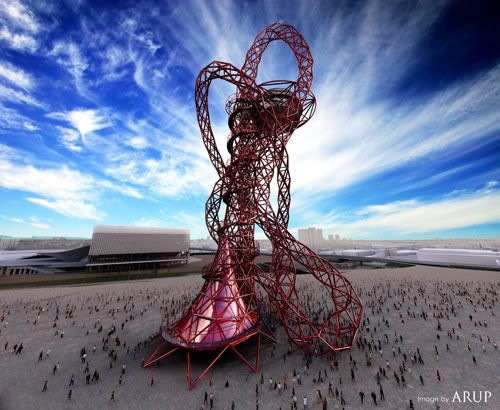Anish Kapoor's design for the London Orbit Tower, intended to be the dominating structure of the London 2012 Olympic Games, was unveiled earlier this week.
When completed, the structure will stand over 115 meters tall - 22 meters higher than the Statue of Liberty, 19 meters higher than Big Ben, and considerably shy of the Eiffel Tower - the 340 meter high building to which the Orbit is already drawing comparisons.
Kapoor has created numerous well-known sculptures, including Chicago's Cloud Gate. Explaining his inspiration for the design, Kapoor remarked in an interview with the BBC that he wanted to "look again at the whole idea of a tower" replacing its traditional Cartesian lines with something more orbital, with a "flowing, coiling form". Moreover, he hopes "to create a sensation of a certain kind of instability' for the viewer.”
Mr. Kapoor, who admittedly has all the humility of Howard Roark, confesses that he makes art to please himself, although he has a viewer in mind. While statements like this have led some art critics to dismiss him as an egoist, I appreciate his honesty. Genuine humility would make innovation impossible. It requires a great deal of confidence to see one's work come to fruition, and I don't really see the point in artists pretending that their work is for the people. In fact, which is more arrogant: admitting that your work pleases you, or proudly asserting that it is meant please others?
For this reason, the Orbit/Eiffel Tower comparison actually works on a certain level. Much like the Orbit, the Eiffel Tower was an unapologetically modern structure that utilized revolutionary techniques in building construction. It was the tallest building in the world for 41 years, until the Chrysler building was completed in 1930. The Orbit does not attempt to compete with the Eiffel Tower in height (which would be rather pointless, since there many tall buildings). Nor does it have the concern with utility that dominated Gustave Eiffel’s work. Instead, Mr. Kapoor seems to feel that the next frontier in construction lies in manipulating the conceptual framework of structures like the tower. His plan for the Orbit puts a tremendous strain on the engineers involved, demanding a building that looks like it might topple over, but doesn't! Kapoor hopes that the innovations he has made in the Orbit's design will make it "truly 21st century."
The Orbit seems based on a visual conception of the relationship between man’s achievements and his limitations. The "leaning tower" can easily be interpreted to represent the instability of modern man. This is emphasized by the sinuous coils of the structure, which call to mind the tenuously twisted spirals of the DNA’s double helix. Of course, the entire structure appears to be on the verge of either collapse or ascent.
My biggest reservation about the project is its full name: the ArcelorMittal Orbit; so named after ArcelorMittal, the company which will be donating the structural steel required to complete the project (perhaps explaining the choice of building material?). I'm a bit disappointed with the red portion of the tower, which appears to be painted steel. How often the tower will need to be repainted? The Eiffel Tower was constructed out of cast iron, and has to be repainted every seven years to prevent corrosion (it takes about 60 tonnes of paint each time). Contemporary construction projects should be made greener by utilizing new materials that are more resistant to corrosion.
So, will the ArcelorMittal Orbit be London's landmark for the 21st century? I'm reserving judgement. People thought the Eiffel Tower was an eyesore when it first opened, so I know better than to criticize the Orbit based on its looks! That said, does the design have staying power? My answer would be yes, because I think that, upon completion, it will be the most prominent example of an honest contemporary architecture that at once embraces the technologies of the 21st century, while calling attention to a dominating sense of uncertainty about the future and our place within it.
Image courtesy ARUP/Getty Images, under fair use guidelines.



5 comments:
I think it will be a lot of fun to hear all the debate about the tower. It is certainly interesting and is sure to provoke a lot of strong feelings! I hope construction plans will include a very good restaurant. The author Guy de Maupassant dined in the restaurant in the base of the Eiffel Tower as often as possible, claiming that it was the only place in Paris where the tower didn't spoil the view!
I feel drawn to its sinuous shape, and yet there is something about it that is hard to embrace. I'm not sure . . .
You always have the most thought provoking post. Thank you!
Nancy
The recent Kapoor exhibition at the Royal Academy of Arts was one of the most fun exhibition I have been too.
http://thesurreydreamtime.blogspot.com/2009/11/note-from-exhibition.html
This is tower is very ambitious and you are right to reserve judgment of whether it will last. The cost is going to be a major issue as the Olympic budget is likely to be cut.
Everyone decried the London Eye, but it now seems a permanent fixture on the London sky line. I scoffed and had to be dragged to it, but I was very impressed. More so when little one banged on the window and nothing happened.
Of course, we do have have the example of the Wembley Tower.
http://en.wikipedia.org/wiki/Watkin%27s_Tower
And finally, not sure if you have seen this book? Well worth a look, if you can find a copy.
http://www.amazon.co.uk/London-as-Might-Have-Been/dp/071954131X/ref=sr_1_3?ie=UTF8&s=books&qid=1270502510&sr=8-3
It does bring mixed feelings ... interesting ... but ???
I guess we will need to see it in context.
Yes, I still have some mixed feelings about it too. I guess we'll be able to see it realized soon enough!
Post a Comment